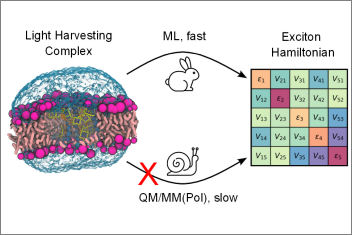 We propose a machine learning (ML)-based strategy for an inexpensive calculation of excitonic properties of light-harvesting complexes (LHCs). The strategy uses classical molecular dynamics simulations of LHCs in their natural environment in combination with ML prediction of the excitonic Hamiltonian of the embedded aggregate of pigments. The proposed ML model can reproduce the effects of geometrical fluctuations together with those due to electrostatic and polarization interactions between the pigments and the protein.
We propose a machine learning (ML)-based strategy for an inexpensive calculation of excitonic properties of light-harvesting complexes (LHCs). The strategy uses classical molecular dynamics simulations of LHCs in their natural environment in combination with ML prediction of the excitonic Hamiltonian of the embedded aggregate of pigments. The proposed ML model can reproduce the effects of geometrical fluctuations together with those due to electrostatic and polarization interactions between the pigments and the protein.
Leggi tutto: A Machine Learning Approach for Fast Exciton Hamiltonians
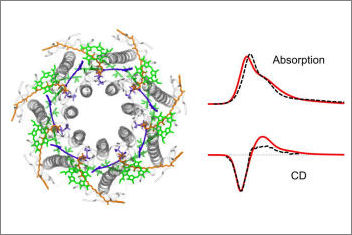 Purple bacteria synthesize highly symmetric protein complexes which contain bacteriochlorophyll and carotenoid pigments, and serve as molecular antennas to harvest sunlight. These antenna complexes called LH2 come in diverse shapes and sizes, but only recently a new complex with a highly unusual sevenfold symmetry was discovered. We investigated how the shape of this new LH2 complex is related to its spectroscopic properties, exploiting a combined strategy that we have developed in the last years.
Purple bacteria synthesize highly symmetric protein complexes which contain bacteriochlorophyll and carotenoid pigments, and serve as molecular antennas to harvest sunlight. These antenna complexes called LH2 come in diverse shapes and sizes, but only recently a new complex with a highly unusual sevenfold symmetry was discovered. We investigated how the shape of this new LH2 complex is related to its spectroscopic properties, exploiting a combined strategy that we have developed in the last years.
Leggi tutto: Our study on a bacterial antenna complex published in Photosynthesis Research
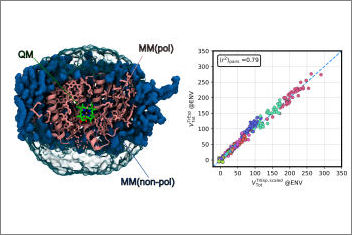 Electronic couplings are key to understanding exciton delocalization and transport in natural and artificial light harvesting processes. We develop a method to compute couplings in multichromophoric aggregates embedded in complex environments without running expensive quantum chemical calculations. We use a transition charge approximation to represent the quantum mechanical transition densities of the chromophores and an atomistic and polarizable classical model to describe the environment atoms.
Electronic couplings are key to understanding exciton delocalization and transport in natural and artificial light harvesting processes. We develop a method to compute couplings in multichromophoric aggregates embedded in complex environments without running expensive quantum chemical calculations. We use a transition charge approximation to represent the quantum mechanical transition densities of the chromophores and an atomistic and polarizable classical model to describe the environment atoms.
Leggi tutto: New Article in The Journal of Physics: Condensed Matter
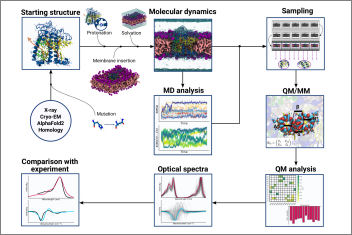 The function of light-harvesting complexes is determined by a complex network of dynamic interactions among all the different components: the aggregate of pigments, the protein, and the surrounding environment. Complete and reliable predictions on these types of composite systems can be only achieved with an atomistic description. In the last few decades, there have been important advances in the atomistic modeling of light-harvesting complexes. These advances have involved both the completeness of the physical models and the accuracy and effectiveness of the computational protocols.
The function of light-harvesting complexes is determined by a complex network of dynamic interactions among all the different components: the aggregate of pigments, the protein, and the surrounding environment. Complete and reliable predictions on these types of composite systems can be only achieved with an atomistic description. In the last few decades, there have been important advances in the atomistic modeling of light-harvesting complexes. These advances have involved both the completeness of the physical models and the accuracy and effectiveness of the computational protocols.
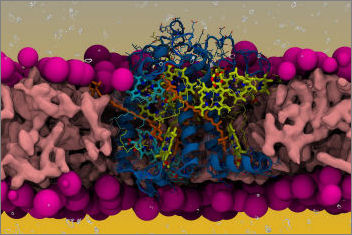 Light-harvesting complexes can transfer excitation energy to the reaction centres when in a light-harvesting regime, and instead dissipate the absorbed light as heat when in a quenching regime induced under high-light conditions. Conformational rearrangements of the protein matrix are thought to play a key role in affecting the interactions of the bound pigments, allowing or disallowing energy transfer between them and therefore changing the activity regime. However, the identity of such conformations is not known.
Light-harvesting complexes can transfer excitation energy to the reaction centres when in a light-harvesting regime, and instead dissipate the absorbed light as heat when in a quenching regime induced under high-light conditions. Conformational rearrangements of the protein matrix are thought to play a key role in affecting the interactions of the bound pigments, allowing or disallowing energy transfer between them and therefore changing the activity regime. However, the identity of such conformations is not known.
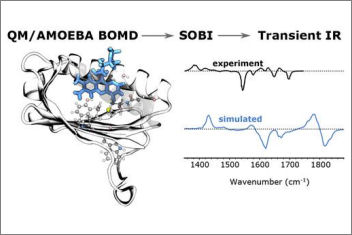 Ultrafast transient infrared spectroscopy is a powerful technique that not only indicates the dynamic structural changes of protein-bound chromophores involved in a photochemical reaction but also reveals the implications of those parts of the protein that contribute in that reaction. In our J. Phys. Chem. paper, we design a novel strategy to compute the transient IR spectra of a protein-bound chromophore using multiscale polarizable QM/MM MDs of both ground and excited states trajectories of the protein.
Ultrafast transient infrared spectroscopy is a powerful technique that not only indicates the dynamic structural changes of protein-bound chromophores involved in a photochemical reaction but also reveals the implications of those parts of the protein that contribute in that reaction. In our J. Phys. Chem. paper, we design a novel strategy to compute the transient IR spectra of a protein-bound chromophore using multiscale polarizable QM/MM MDs of both ground and excited states trajectories of the protein.
Leggi tutto: New Article in The Journal of Physical Chemistry







